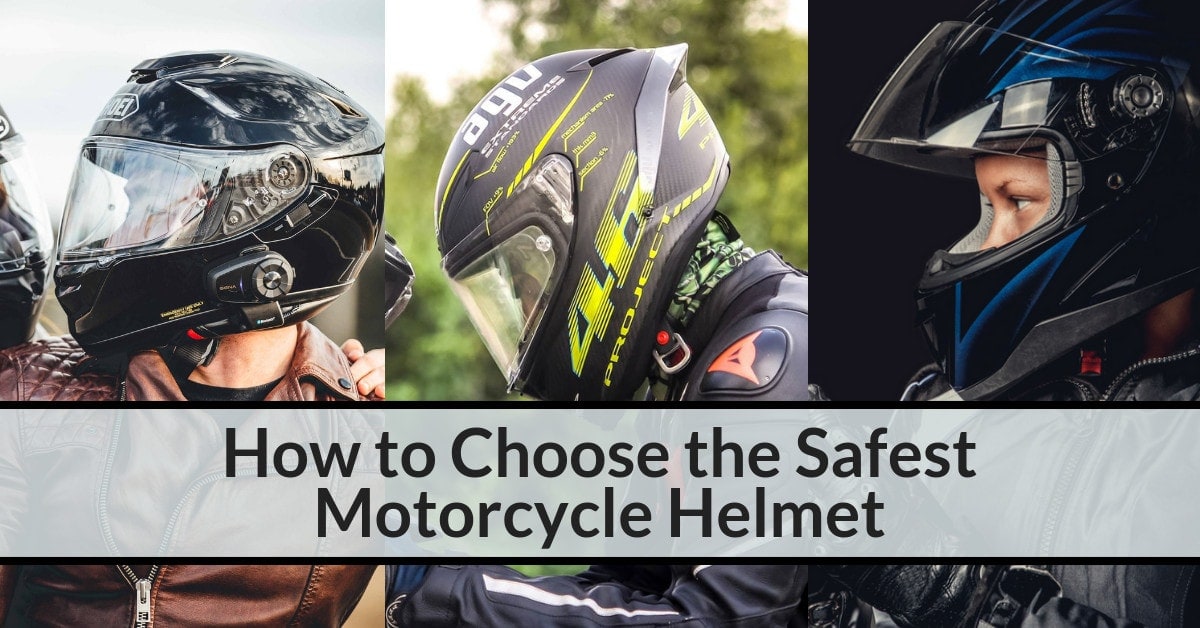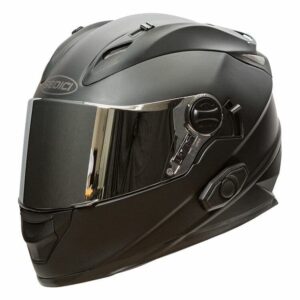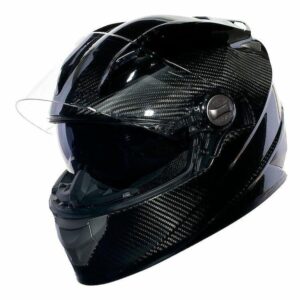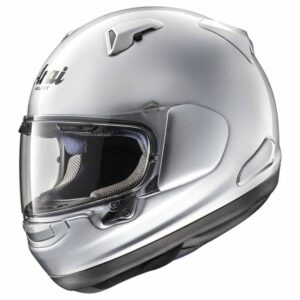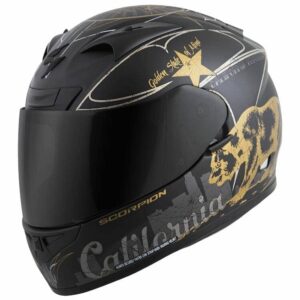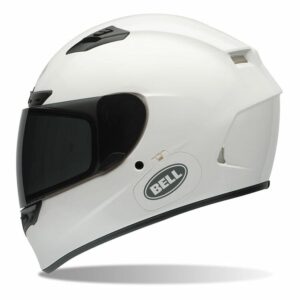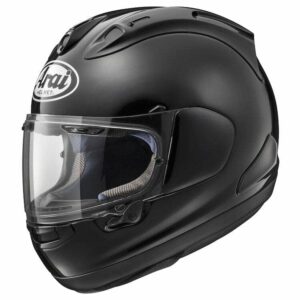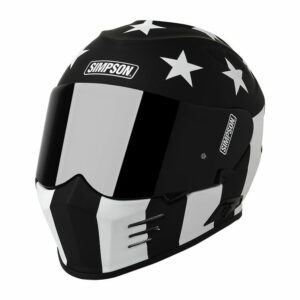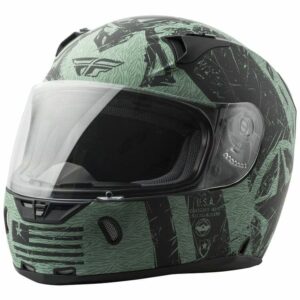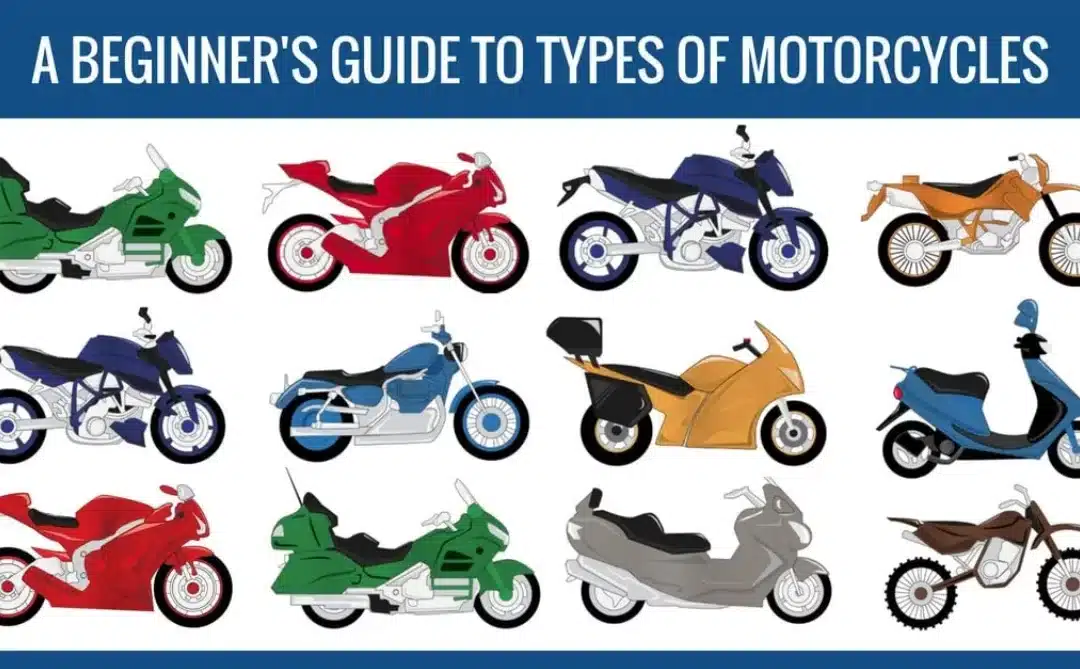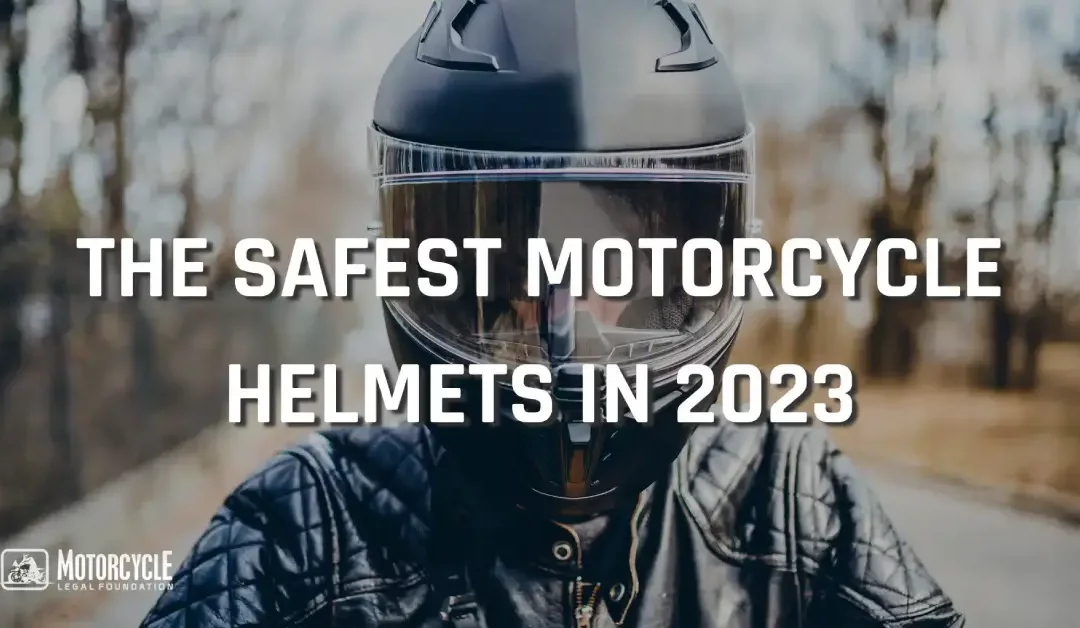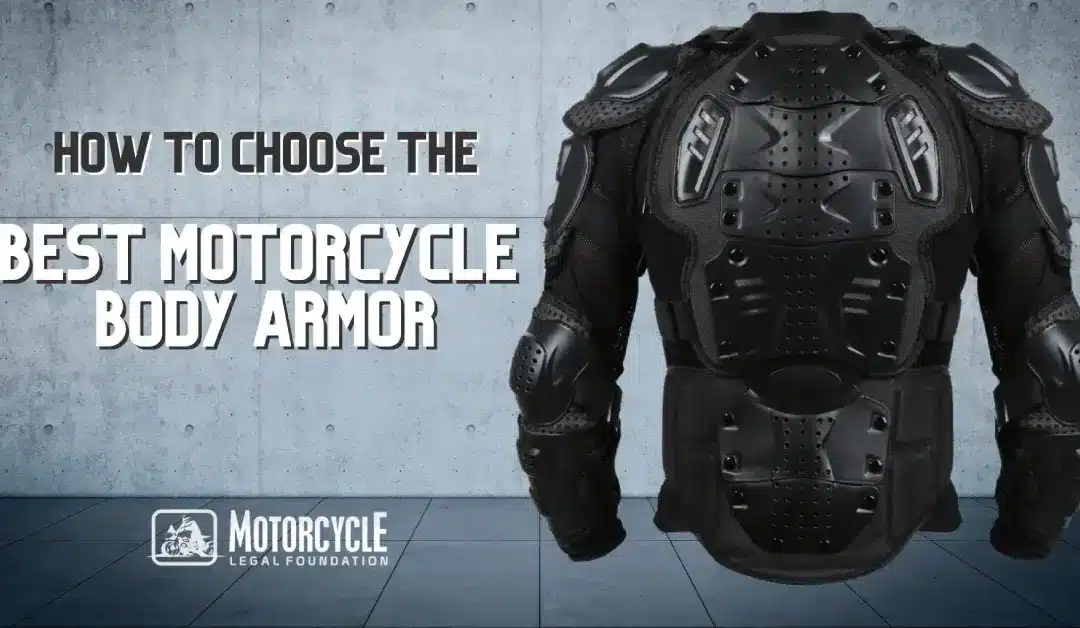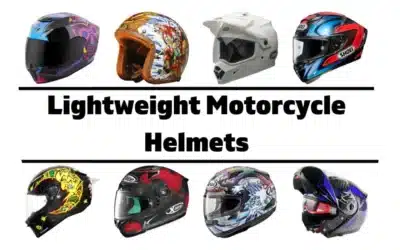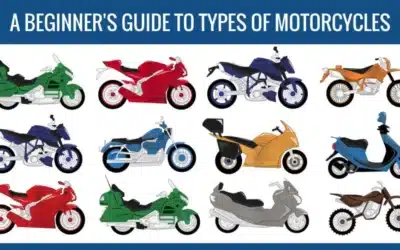Safest Motorcycle Helmet Type
Motorcycle Helmet Safety Standards
Snell Memorial Foundation (M-95 / M2000)
D.O.T. (Department of Transportation FMVSS218)
European Standard 22/05
European BSI 6658-85 Type A
SHARP
Motorcycle Helmet Fit
When To Replace Your Motorcycle Helmet
Top 12 Safest Motorcycle Helmets
Motorcycling is thrilling. Feeling the freedom of the open road and the wind running across your body is something that is hard to describe. With motorcycling, comes the acronym, ATGATT (All The Gear All The Time). When you consider the acronym ATGATT, the motorcycle safety gear that comes to mind is the helmet. In 2015, the use of motorcycle helmets saved an estimated 1,772 lives and 740 lives could have been spared had the motorcyclist worn a helmet. Whether the law requires it or not, you should ALWAYS ride with a helmet.
Safest Motorcycle Helmet Type
There are numerous styles of helmets, but the three main designs are the full face, ¾, and the ½ helmet. In regards to safety, the full face helmet is the safest choice of the three.
The full face helmet offers the most coverage surrounding your head and neck. A full-face helmet protects you from the environment you’re riding in, whether it be inclement weather or debris and bugs hitting your visor. One of the distinguishing features of a full face helmet is a chin bar, which ¾ and ½ helmets lack. According to an Australian study, the chin encounters fifty percent of severe impacts during an accident. Only a full face helmet will offer you the protection to keep your chin and jaw safe.
“Whenever you go out to get yourself a new helmet, always look for shell-built design,” says motorcycle blogger, Motorcyclist Lifestyle. “It is the first line of defense which protects your head to avoid direct contact with the road. [Choose] another helmet if the helmet you picked doesn’t have thermoplastic or reinforced composite shell like polycarbonate. The second feature to look for is the impact absorbing liner. As the name suggests, it the inner liner of the helmet which not only gives comfort to your top head but absorbs impact in crashes. It is the second line of defense which protects you from severe head injuries. The third feature is the chin strap. A helmet can only do its job if its properly strapped. ”
One sticking point that you see a lot of banter on is the cost of a full face helmet and why the higher cost is a result of more or better safety. The truth is that cost doesn’t necessarily equate to more safety. Helmet manufacturers have standards like the Snell Foundation requirements, DOT (Department of Transportation), and the current European Safety Standard 22/05 to meet to ensure a good quality product is released to the public. Beyond those criteria, the cost is more driven by materials used to make the helmet, features available, and the visual aesthetics of the helmet.
Motorcycle Helmet Safety Standards
There are several safety standards for motorcycle helmets, and knowing what they cover can be confusing. They can overlap in requirements, and have different criteria in other respects.
According to motorcycle blogger, Motorbike Writer, “The most important feature in a helmet is its safety rating, so I’d check official ratings such as the UK SHARP website” (which will be discussed below). Here are the main safety standards and what you need to know about each:
Snell Memorial Foundation (M-95 / M2000)
The Snell Foundation certification is not a requirement by law in the United States (or around the world), but they go above and beyond the minimum criteria to thoroughly test helmets in many respects. Beyond motorcycle helmets, they test for bicycling, karting, and professional motorsports. Below are the safety features they test for:
- Impact Testing – The impact test uses controlled impacts to simulate different impact surfaces. The object is to measure gravitational (G) force or acceleration. If the peak acceleration in any test exceeds a value, the helmet is rejected.
- Positional Stability (Roll-Off) Test – A head form is mounted so that it points face downward at an angle of 135 degrees. The helmet is placed on the head form and the straps and buckles adjusted to obtain a best fit condition. A weight is connected via wire rope and dropped from a determined height. The helmet is turned 180 degree and the test conducted again. The helmet may shift, but must not roll off the head form to pass the test.
- Dynamic Retention Test – The helmet is placed on a head form with the chin strap fastened under a device representing the jaw. The jaw piece has a 23 kg weight applied for around one minute. The retention system is tested by simultaneously removing the 23 kg weight and applying a 38 kg mass in an abrupt guided fall. The retention system fails if it cannot support the mechanical loads or if the maximum instantaneous deflection (stretch) exceeds 30 mm (1.18 inches).
- Chin Bar Test – The test helmet is attached to a base with the chin bar facing upward. A 5 kg weight is dropped to hit the central portion of the chin bar. Maximum downward deflection of the chin bar must not exceed the stated distance.
- Shell Penetration Test – The test helmet is attached to a base. A sharp pointed 3-kg object is dropped from a prescribed height. The test striker must not penetrate the helmet or even achieve momentary contact with the head form inside the helmet.
- Faceshield Penetration Test – The face shield (also called a visor) is attached to a test helmet and shot along the center line in three separate places with an air rifle. The rifle shoots sharp soft lead pellets at speeds approximately at 500 kph (310 miles per hour). The pellets must not penetrate the visor for it to pass the test.
D.O.T. (Department of Transportation FMVSS218)
FMVSS218 is the technical standard that defines the minimum criteria that a helmet manufacturer must certify against in the United States. It’s simply known as the D.O.T. helmet standard certification generally. The tests are very similar to the Snell Memorial tests, but the judged values are slightly different on criteria for impact, severity, and test equipment used. The Snell certification is more difficult to pass than the DOT testing. One additional note is that the manufacturer certifies their own helmets in their own labs, whereas Snell tests and certifies any helmet submitted to them from any manufacturer.
European Standard 22/05
The European standard is very similar to the DOT and Snell testing. The values and tests vary slightly on most criteria, and it also adds a retention standard testing for slipping, abrasion, retention, and durability. One additional test for helmet shell rigidity is done under the ECE 22/05 standard that is not done under Snell or DOT.
European BSI 6658-85 Type A
Europe also has a second standard that helmets are measured by, and it is very close to the Snell testing scheme. Passing values on certain tests vary slightly from the Snell standard, but many of the categories list the values as the “same as the Snell M2005 test” as a reference. The BSI tests also incorporate the chin strap slippage, retention, and abrasion testing seen on the ECE 22/05 testing.
SHARP
SHARP is a testing a rating system only available for helmets sold in the UK (United Kingdom / England). It measures just impact protection of the helmet based on similar testing to the other standards and rates helmets with a star rating system instead of a pass / fail result. The ratings are shown from a 1-star (lowest) to a 5-star (highest).
Motorcycle Helmet Fit
Each manufacturer helmet will fit slightly different. One brand may be a better fit for a round head, while others may fit better for an oval shape. You can read reviews from each manufacturer, but you may get the best understanding of what will fit you best by trying a few one. Sizing will vary from brand to brand, therefore, a medium in one brand may fit like a large in another. Again, trying on a few may give you the best feedback.
Current helmet technology involves an inner liner to absorb shock, made of EPS (expanded polystyrene) foam. There is a comfort liner that riders often mistake for a protective component, which also does provides some padding. A helmet should also have EPS foam in the lower area to properly protect the face and jaw.
Fit is essential to finding the best helmet for you. What needs to fit is the EPS liner, not the comfort liner. A rough measurement should be taken from above the eyebrows, around the head at the furthest point of the back of the head, and around. A helmet must always be tried on, and checked for fit. The chin strap should be tightened so that only two fingers will fit between the strap and the head. There should be no gaps at the top, front, back, or side of the head, although it should not be painfully tight. The helmet should be worn for a few minutes to gauge the fit. If you attempt to rotate the helmet, your cheeks should move. If the helmet moves or slips with rotation, or up and down, it is not a good fit. To test the chin strap, look down toward your chest, and see if the back of the helmet can be pushed upward. If Goldilocks went helmet shopping, she’d find a helmet that isn’t too large or too small. She’d find one that is just right, and you should too.
Keep in mind that there are non-safety factors that make a big difference. These include the feel of the safety liner, the amount of air flow, and the size and shape of the eye opening. Sound level is somewhat of a safety consideration, because it affects what is heard, and because wind noise over time will damage your hearing. Weight is more a comfort factor than a safety factor, but in an accident, the physics of weight may make a difference.
At the end of the day, the most important thing is that the helmet fits your head correctly, and that the chin strap holds it on your head.
When To Replace Your Motorcycle Helmet
Motorcycle helmets should be replaced every five years, assuming you have not had any direct impacts that would jeopardize the impact protection of the helmet. This recommendation is from a consensus of helmet manufacturers and the Snell Memorial Foundation after studying the effects on a helmet from regular use. Helmet degradation is caused by normal wear and tear, hair oils, and body fluids and cosmetics. Cleaners, paints, fuels and other materials also affect the liner materials and overall helmet performance.
Top 12 Safest Motorcycle Helmet Recommendations
There are many new helmets to choose from and it would take a long time to look through every helmet manufacturer to find the safest helmets out there. We have done that search for you and have identified 12 helmets that meet multiple certifications with some extra styling and features to look into.
- Shoei RF-1200
Price:$485 – $499
Safety Standard: Snell M2015 and DOT certifiedThe Shoei RF-1200 is designed to be lightweight and safe. It features a dual-impact liner with layers of different densities and an effective shell to minimize impact. Beyond the impact protection, the comfort features include a great ventilation system to keep you cool while riding. On the cooler rides, a chin guard and a breath guard will keep you warmer by channeling air around the helmet while keeping the visor clear.

- Sedici Strada Palare SENA Bluetooth
Price: $350
Safety Standard: DOT and ECE 22/05 certifiedThe Sedici Strada helmet features a fiberglass shell infused with Kevlar to increase rigidity and impact resistance. Beyond a solid structure, it features good ventilation to keep you cool and dry and also a sunshade to easily transition from a clear visor to a darker visor to prevent too much from sun blinding you. One additional feature is the Bluetooth system that can be paired with any enabled device or can be used to communicate between riders in a close proximity.

- Sedici Strada Carbon
Price: $300
Safety Standard: DOT and ECE 22/05 certifiedThe Sedici Strada Carbon helmet features a shell made from carbon fiber infused with Kevlar to decrease its weight, while making the helmet very impact resistant. It comes in two finishes: gloss or matte. Beyond these features, it also has a polycarbonate scratch-resistant visor that will stay free from scratches and fogging making it safe in all weather conditions you choose to ride in.

- Icon Airmada Chantilly
Price: $250
Safety Standard: DOT FMVSS 218 (US), ECE 22-05 (EU), SAI AS1698 (AU) & SG (Japan) certifiedThe Icon Chantilly helmet features a lightweight polycarbonate construction to resist impact and offer superior protection with a dual-density EPS liner. Beyond the helmet construction, it features an adjustable chin and forehead venting system, plus a molded breath deflector to prevent visor fogging. The anti-bacterial liner is also removable for easy cleaning between rides.

- Arai Signet-X
Price: $612 – $630
Safety Standard: Snell M2015 and DOT certifiedThe Arai Signet-X continues on with Arai’s tradition of lightweight helmet construction and superior performance. Each helmet is constructed with a proprietary laminate process involving multiple materials for performance and strength. The Signet-X features a visor system that latches closed for extra safety and also has a slightly cracked position for venting and fogging prevention.

- Scorpion EXO-R710 Golden State Edition
Price: $210
Safety Standard: Snell M2015 certifiedScorpion is one of those brands you may not recognize as a performance helmet manufacturer. The EXO-R710 is constructed from Aramid and fiberglass for a low cost but performance based helmet. The helmet also has a dual-density EPS layer for extra impact resistance and protection. Beyond the shell, the helmet features a moisture wicking liner that keeps you dry and a good ventilation system that keeps you cool. The visor features fog-free technology to keep your visor clear and clean, which keeps you safe seeing the road ahead. The visor will also lock into a down position to prevent debris entering your helmet at speed.

- Bell Qualified DLX
Price: $250
Safety Standard: DOT and ECE 22/05 certifiedBell has raised the bat with features on the DLX helmet. It features a polycarbonate shell for impact resistance, but adds a completely removable interior liner that is easy to clean and care for. One interesting feature is a visor that transitions from clean in low light levels to a darker tint in bright sunlight. It protects your vision in all light levels and you don’t need to do anything. Beyond the tint transition it is anti-fogging and has an anti-scratch coating.

- Arai Corsair X
Price: $765 – $774
Safety Standard: Snell M2015 and DOT certifiedThe Arai Corsair X has a rounded design that helps to disperse energy and reduce impact forces compared to other Arai helmets. Beyond the well-designed shell, it features a ventilation system that keeps air from entering below the helmet and increases ventilation efficiency to keep the visor fog free and the rider’s head cool. The liner is removable and adjustable to fit the rider’s head more comfortably.

- HJC CL-17 Phantom Women’s Helmet
Price: $135
Safety Standard: DOT and Snell M2015 certifiedThe HJC CL-17 helmet features a lightweight polycarbonate shell that incorporates a great ventilation system that is designed to keep you cool and dry in every ride. The liner is removable for easy cleaning and is anti-microbial to extend the riding time between needed cleanings. The visor is made from anti-scratch material which will help keep it scratch-free and easy to see through when you’re riding.

- Simpson Ghost Bandit Monochrome
Price: $480
Safety Standard: DOT and ECE 22/05 certifiedThe Simpson Ghost Bandit helmet is constructed from a lightweight composite material that features a removable anti-microbial liner. Beyond that it has an internal visor to block direct sunlight and keep the light levels lower on your eyes. One feature that you can also use is the integrated pockets for mic and speakers inside the helmet for Bluetooth communication.

- Icon Airflite Quicksilver
Price: $290
Safety Standard: DOT FMVSS 218 (US), ECE 22-05 (EU), SAI AS1698 (AU) & SG (Japan) certifiedThe Icon Airflite Quicksilver helmet features an injection molded polycarbonate shell that keeps it lightweight yet strong to deflect impacts. Beyond the customized shell, it features an internal visor to adjust the sunlight levels for your eyes. If you’re riding in cooler weather, an internal breath deflector will keep your visor from fogging and remain scratch free.

- Fly Racing Street Revolt FS Liberator
Price: $150
Safety Standard: DOT and Snell M2015 certifiedThe Fly Racing helmet flies under the radar, but features some top-of-the-line creature comforts. The shell is made from a lightweight polycarbonate ABS alloy, which keeps it light and strong. The construction features a dual-density EPS (Expanded Polystyrene) liner for progressive impact absorption in the case of a mishap. The interior liner is anti-microbial and removable for cleaning. It comes with two shields that are anti-scratch and will remain free from fogging in cooler weather.
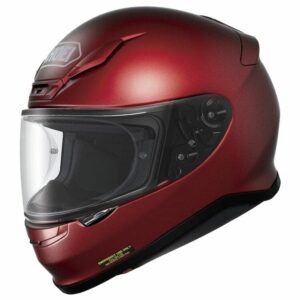
All motorcycle helmets aren’t created equal. While most full-face helmets meet certification criteria for the Department of Transportation, only a select few manufacturers go beyond that standard and have their products tested against the Snell Memorial Foundation criteria. When you’re looking for a new helmet, as a new rider or a replacement at the 5-year mark, it’s up to you to decide if you want a helmet that just meets the DOT or ECE 22/05 standard or goes beyond for Snell certification. All will protect you in the event of a mishap. Perhaps the difference will come down to the features and materials available. Good luck!

